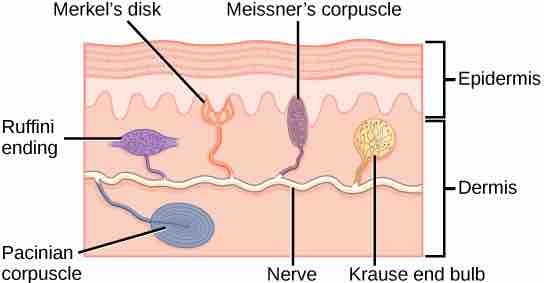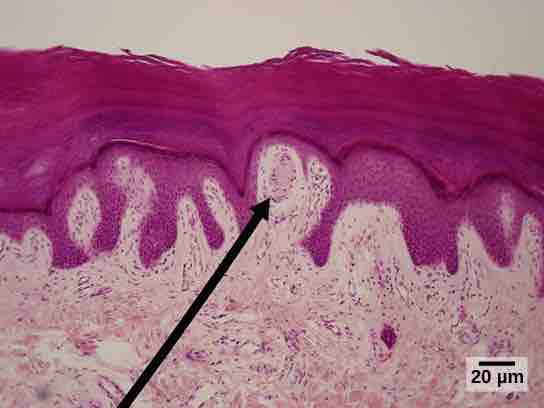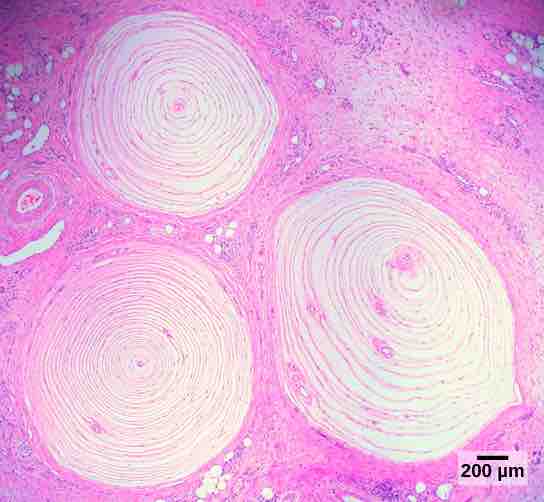Somatosensory Receptors
Sensory receptors are classified into five categories: mechanoreceptors, thermoreceptors, proprioceptors, pain receptors, and chemoreceptors. These categories are based on the nature of the stimuli that each receptor class transduces. Mechanoreceptors in the skin are described as encapsulated or unencapsulated. A free nerve ending is an unencapsulated dendrite of a sensory neuron; they are the most common nerve endings in skin. Free nerve endings are sensitive to painful stimuli, to hot and cold, and to light touch. They are slow to adjust to a stimulus and so are less sensitive to abrupt changes in stimulation.
Mechanoreceptors
There are three classes of mechanoreceptors: tactile, proprioceptors, and baroreceptors. Mechanoreceptors sense stimuli due to physical deformation of their plasma membranes. They contain mechanically-gated ion channels whose gates open or close in response to pressure, touch, stretching, and sound. There are four primary tactile mechanoreceptors in human skin: Merkel's disks, Meissner's corpuscles, Ruffini endings, and Pacinian corpuscle; two are located toward the surface of the skin and two are located deeper . A fifth type of mechanoreceptor, Krause end bulbs, are found only in specialized regions.

Primary mechanoreceptors
Four of the primary mechanoreceptors in human skin are shown. Merkel's disks, which are unencapsulated, respond to light touch. Meissner's corpuscles, Ruffini endings, Pacinian corpuscles, and Krause end bulbs are all encapsulated. Meissner's corpuscles respond to touch and low-frequency vibration. Ruffini endings detect stretch, deformation within joints, and warmth. Pacinian corpuscles detect transient pressure and high-frequency vibration. Krause end bulbs detect cold.
Merkel's disks are found in the upper layers of skin near the base of the epidermis, both in skin that has hair and on glabrous skin; that is, the hairless skin found on the palms and fingers, the soles of the feet, and the lips of humans and other primates. Merkel's disks are densely distributed in the fingertips and lips. They are slow-adapting, unencapsulated nerve endings, which respond to light touch. Light touch, also known as discriminative touch, is a light pressure that allows the location of a stimulus to be pinpointed. The receptive fields of Merkel's disks are small, with well-defined borders. That makes them very sensitive to edges; they come into use in tasks such as typing on a keyboard.
Meissner's corpuscles, also known as tactile corpuscles, are found in the upper dermis, but they project into the epidermis . They are found primarily in the glabrous skin on the fingertips and eyelids. They respond to fine touch and pressure, but they also respond to low-frequency vibration or flutter. They are rapidly- adapting, fluid-filled, encapsulated neurons with small, well-defined borders which are responsive to fine details. Merkel's disks and Meissner's corpuscles are not as plentiful in the palms as they are in the fingertips.

Meissner corpuscles
Meissner corpuscles in the fingertips, such as the one viewed here using bright field light microscopy, allow for touch discrimination of fine detail.
Deeper in the dermis, near the base, are Ruffini endings, which are also known as bulbous corpuscles. They are found in both glabrous and hairy skin. These are slow-adapting, encapsulated mechanoreceptors that detect skin stretch and deformations within joints; they provide valuable feedback for gripping objects and controlling finger position and movement. Thus, they also contribute to proprioception and kinesthesia. Ruffini endings also detect warmth. Note that these warmth detectors are situated deeper in the skin than are the cold detectors. It is not surprising, then, that humans detect cold stimuli before they detect warm stimuli.
Pacinian corpuscles, located deep in the dermis of both glabrous and hairy skin, are structurally similar to Meissner's corpuscles. They are found in the bone periosteum, joint capsules, pancreas and other viscera, breast, and genitals . They are rapidly-adapting mechanoreceptors that sense deep, transient (not prolonged) pressure, and high-frequency vibration. Pacinian receptors detect pressure and vibration by being compressed which stimulates their internal dendrites. There are fewer Pacinian corpuscles and Ruffini endings in skin than there are Merkel's disks and Meissner's corpuscles.

Pacinian corpuscles
Pacinian corpuscles, such as these visualized using bright field light microscopy, detect pressure (touch) and high-frequency vibration.